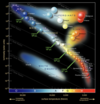AH 1.6 Stellar Physics Flashcards
Define the apparent brightness of a star.

The Luminosity of the Sun is 3.9 x 1026 W m-2. The Earth-Sun distance is 1.47 x 1011 m.
Calculate the apparent brightness of the Sun.
b = L / 4πd2
= 3.9 × 1026 / [4π x (1.47 x 1011 )2]
b = 1.44 x 103 Wm-2
What knowledge of a star is required in order to calculate it’s surface temperature?
The colour of the star or, more specifically, it’s spectrum.
The surface temperature of the sun is 5800 K. Find the power it emits per unit area.
The Stefan–Boltzman constant = 5.67 × 10–8 W m–2 K–4
P = σT4
= 5.67 × 10–8 × (5800)4
P = 6.42 × 107 Wm–2
Derive the equation 𝐿 = 4𝜋𝑟2𝜎𝑇4 …taking care to explain what each symbol means
For any star radius r, the Power emitted per unit area is given by
P= σT4 …σ = the Stefan-Boltzman constant & T = surface Temperaure
The Luminosity L of a star is the total rate at which energy is radiated by its whole surface over all wavelengths. So
L = σT4 x 4πr2 … as the srface area of a sphere is 4πr2

Explain the concept gravitational equilibrium in a star.
Once a star is on the main sequence it is in state of hydrostatic equilibrium.
This means that the inward force of gravitational attraction between all of its own molecules is balanced by the outward force of thermal pressure caused by the heat.
These two forces balance each other, ensuring that the star’s radius remains constant.
Whilst this hydrstatic equilibrium is maintained, the star remains on the main sequence of the Hertzsprung-Russell diagram.
Note
In general there is a balance between Gas Pressure & Gravity.
If Pressure dominates, the star expands.
If Gravity dominates, the star contracts.
I_f Pressure and Gravity balance then the start is in hydrostatc equilibrium and has constant radius._
Describe the fusion process that takes place in stars known as the proton-proton chain
Nuclear fusion in the Sun converts Hydrogen into Helium with the release of energy.
The process is summmarised below:
4 (1H) → 4He + 2e+ + 2 neutrinos + energy
However, the process occurs in several steps, shown in the diagram.

Describe the formation of stars.
Molecular clouds called nebulae form mostly from hydrogen, with lesser quantities of other molecules such as carbon monoxide, ammonia, water and ethanol. In addition, small quantities of dust are commonly found, consisting of carbon, iron, oxygen and silicon.
The molecules are attracted to each other gravitationally. In nebulae, the gravitational attraction between the molecules overcomes the thermal pressure due to their motion and progressively the molecules ‘clump’ together and gradually compress into a core. The process steadily heats the core (the particles move faster) until it reaches a temperature where nuclear fusion can be sustained and radiation is emitted - a star has been formed.
The Luminosity and surface temperature of a star are determined by one physical quanity. What is it?
The mass of the star.
(This, of course, depends on the initial conditions within the nebula in which the star was formed)
Explain what is meant by the Hertzsprung-Russell diagram and comment on its axes.
The Hertzsprung-Russell diagram is a graphical plot of stellar luminosity against temperature for many stars relatively close to Earth.
On the x-axis, temperature decreases to the right. The scale is logarithmic.
On the y-axis, luminosity increases going up. The scale is logarithmic
Sketch a Hertzsrung-Russell diagram and on it clearly draw and label
a) the main sequence
b) red giants
c) supergiants
d) white dwarves

What process is going in and so characterises a main sequence star?
The nuclear fusion of Hydrogen into Helium.
What two important properties of stars change over time?
The luminosity and temperature of stars change over time.
Which stars have a longer lifetime - high or low mass stars?
Low mass stars have a longer lifetime.
Why do higher-mass stars have a shorter lifetime than lower-mass stars?
Higher mass stars have a shorter lifetime since they use up their mass more
quickly.

